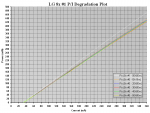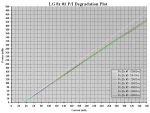Sorry for the update delay. I suffered a bad computer crash yesterday and almost lost the 50 hour data. Luckily Excel is smarter than me and i managed to recover it from a hidden autosave file.
In the meanwhile the cycling went on uninterrupted and the diode has passed 60 hours, so i'm posting a double update.
First the 50 hour data:
Ith = 34mA
Slope Efficiency = 1.3mW / mA
Absolute Efficiency = 20.55% Avg.
Po @ 348mA = 410mW = 90.41% of Initial
The PI line is the yellow one between the 30h (red) and 40h lines (green).
Basically, the power is still a tiny bit higher than it was at 30 hours, with just a tiny bit of degradation since 40h where the power magically went up.
Next the 60 hour data:
Ith = 34mA
Slope Efficiency = 1.294mW / mA
Absolute Efficiency = 20.41% Avg.
Po @ 348mA = 409.65mW = 90.33% of Initial
This time the PI line is pretty much on top of the red one from 30 hours. And the diode is producing practically the same amount of power as it did at that time.
It's as if no degradation has happened in the last 30 hours. That of course can't be true, but the diode didn't lose much power after the first 30 hours. Degradation can still be seen, but in tiny drops from the unexpected jump between 30 and 40h.
Looks like the diode becomes very stable in power after the initial rapid degradation phase. I've never observed behavior like that before, altho it is true i never recorded it in this much detail.
At this rate, this diode has good chances of lasting much longer! It could easily reach or exceed 100 hours now, which is impressive for this amount of power!








